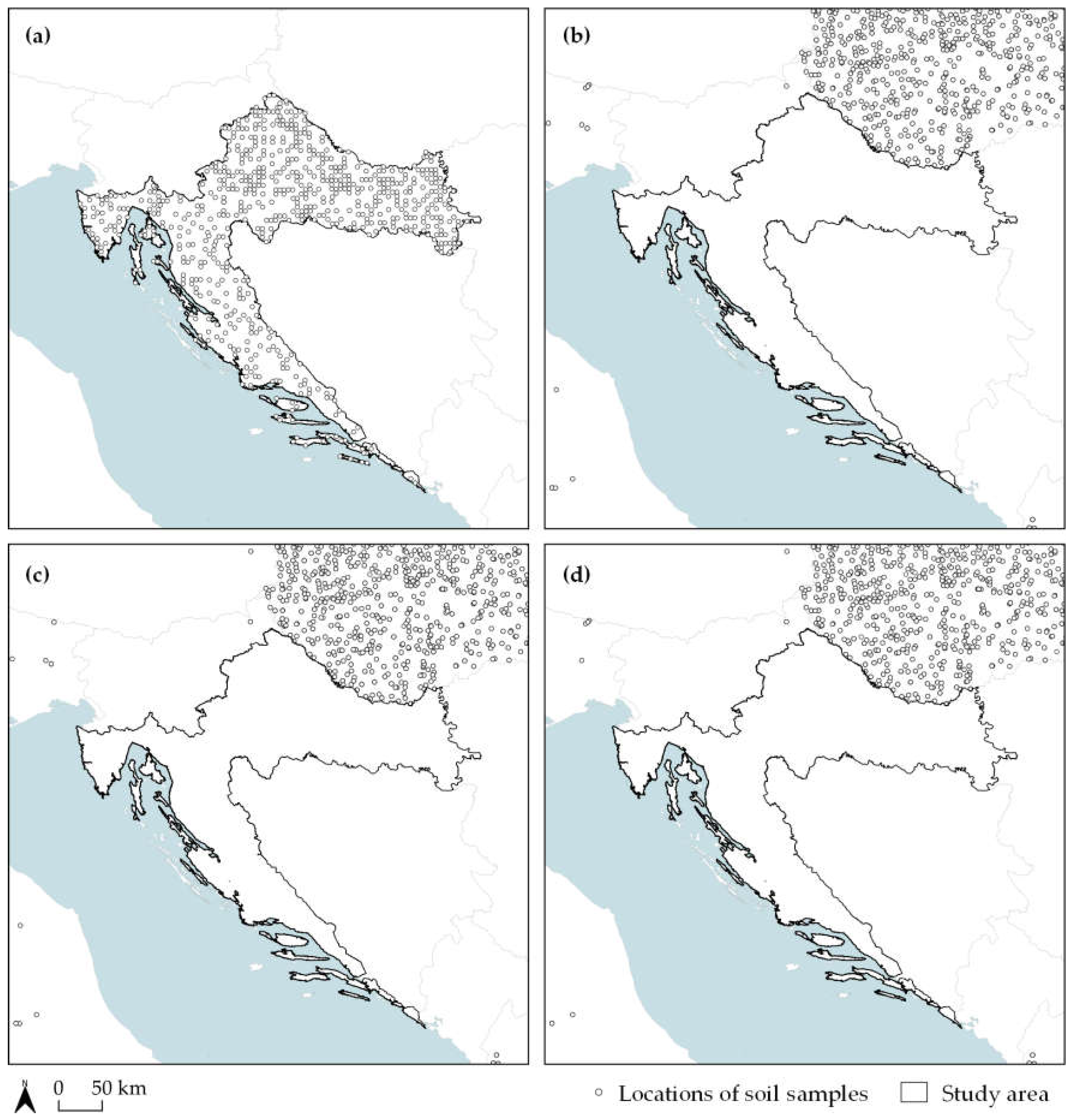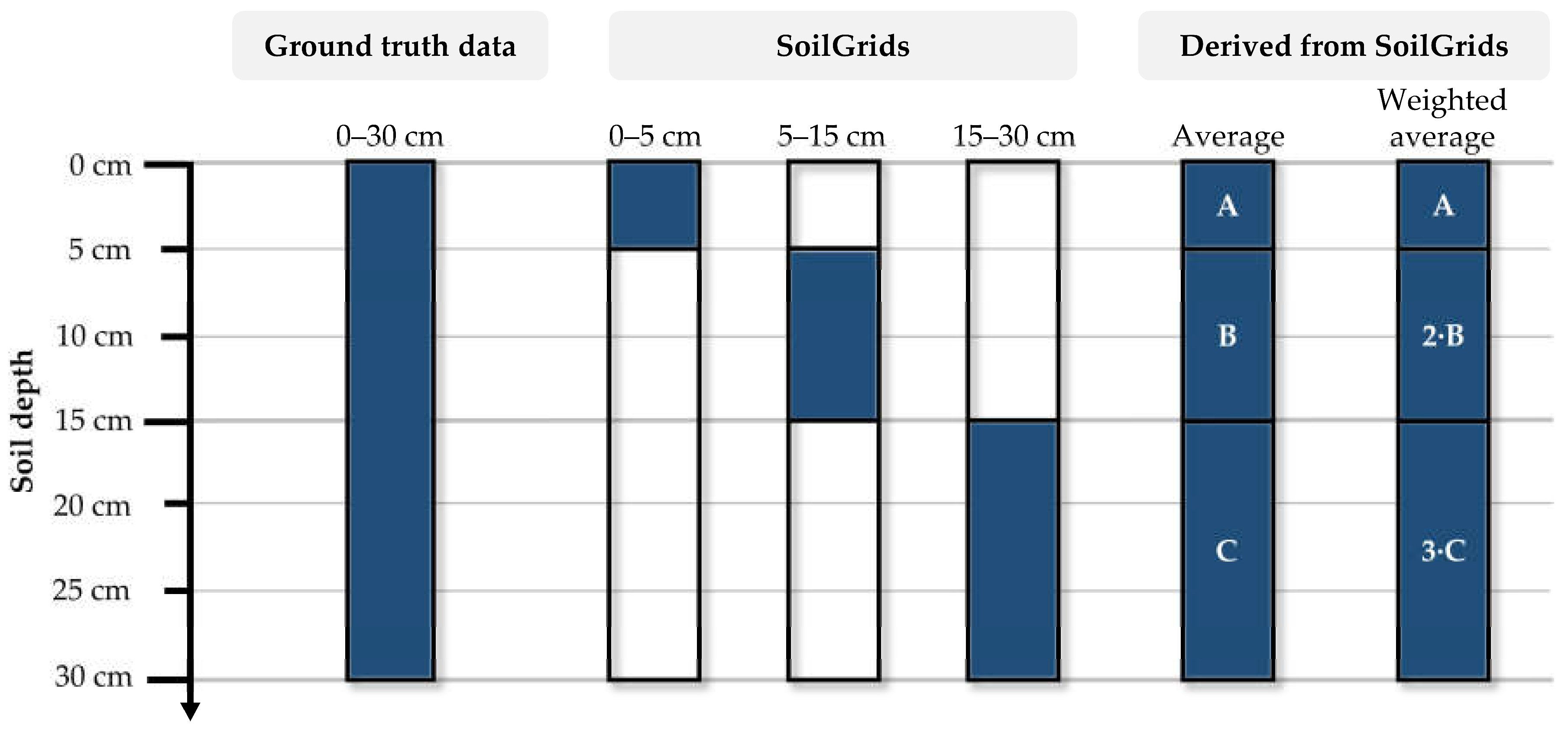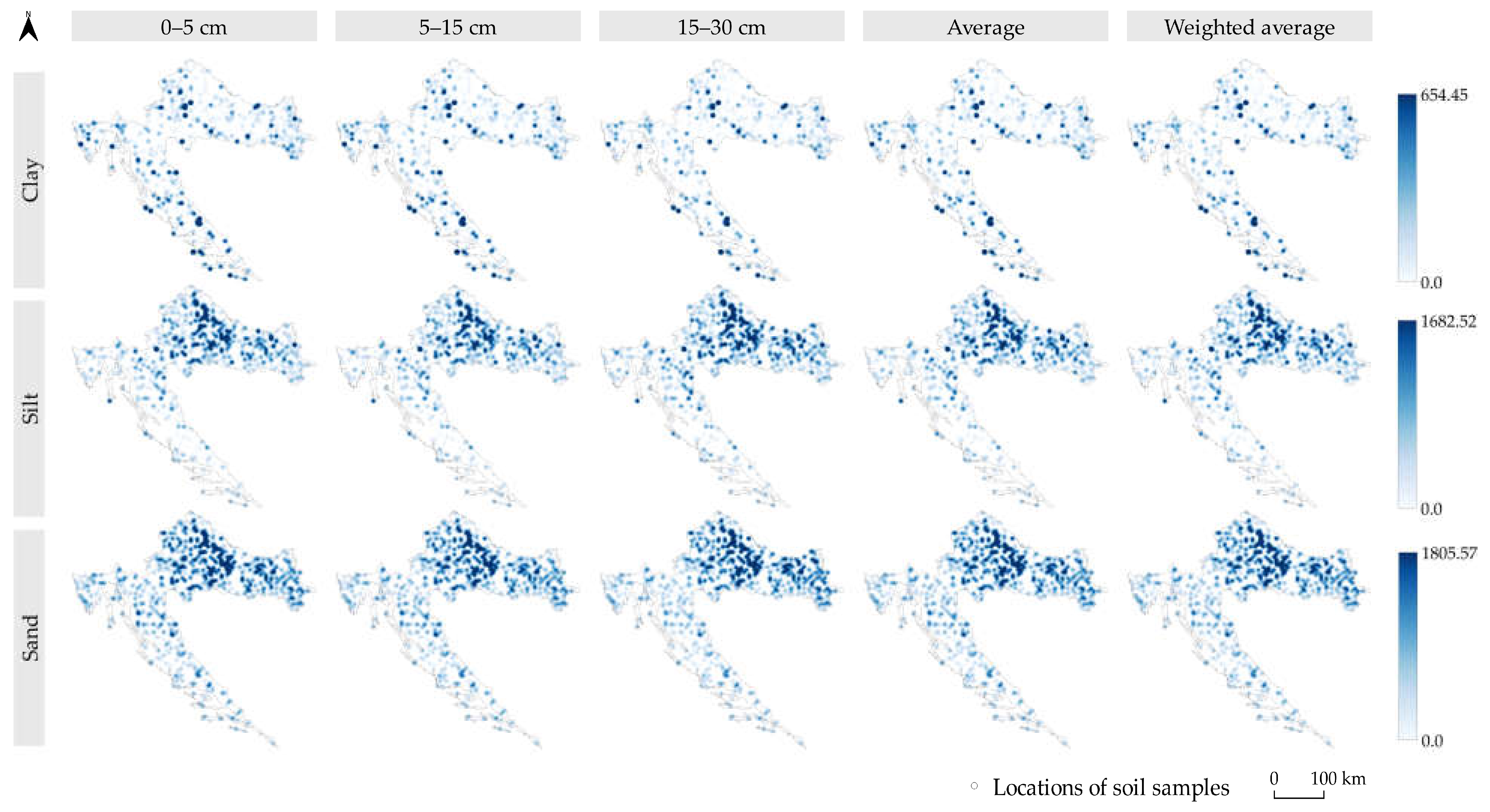An Independent Validation of SoilGrids Accuracy for Soil Texture Components in Croatia
Abstract
:1. Introduction
2. Materials and Methods
2.1. Study Area and Ground Truth Soil Sampling Data
2.2. Acquiring and Preprocessing of SoilGrids Data
2.3. Accuracy Assessment of SoilGrids Based on the Ground Truth Soil Sampling Data
3. Results
4. Discussion
5. Conclusions
Author Contributions
Funding
Data Availability Statement
Acknowledgments
Conflicts of Interest
Appendix A
| Soil Property | Statistical Metric | Soil Layer | Csa | Csb | Cfa | Cfb | Dfb |
|---|---|---|---|---|---|---|---|
| Clay | R2 | 0–5 cm | 0.009 | 0.572 | 0.354 | 0.138 | 0.247 |
| 5–15 cm | 0.008 | 0.456 | 0.344 | 0.126 | 0.251 | ||
| 15–30 cm | 0.014 | 0.813 | 0.337 | 0.127 | 0.248 | ||
| RMSE | 0–5 cm | 12.402 | 4.243 | 10.618 | 10.943 | 9.511 | |
| 5–15 cm | 12.413 | 4.784 | 10.696 | 11.020 | 9.489 | ||
| 15–30 cm | 12.371 | 2.806 | 10.752 | 11.017 | 9.507 | ||
| Silt | R2 | 0–5 cm | 0.026 | 0.478 | 0.010 | 0.129 | 0.000 |
| 5–15 cm | 0.024 | 0.449 | 0.014 | 0.131 | 0.000 | ||
| 15–30 cm | 0.012 | 0.596 | 0.019 | 0.165 | 0.000 | ||
| RMSE | 0–5 cm | 11.004 | 4.621 | 13.469 | 12.481 | 12.159 | |
| 5–15 cm | 11.017 | 4.749 | 13.442 | 12.469 | 12.160 | ||
| 15–30 cm | 11.080 | 4.067 | 13.409 | 12.218 | 12.160 | ||
| Sand | R2 | 0–5 cm | 0.020 | 0.416 | 0.014 | 0.094 | 0.078 |
| 5–15 cm | 0.022 | 0.536 | 0.012 | 0.091 | 0.070 | ||
| 15–30 cm | 0.030 | 0.238 | 0.013 | 0.074 | 0.090 | ||
| RMSE | 0–5 cm | 16.347 | 0.667 | 12.742 | 11.131 | 12.994 | |
| 5–15 cm | 16.333 | 0.595 | 12.753 | 11.144 | 13.049 | ||
| 15–30 cm | 16.264 | 0.762 | 12.749 | 11.248 | 12.907 |
| Soil Property | Statistical Metric | Soil Layer | Agricultural Areas | Forests and Seminatural Areas |
|---|---|---|---|---|
| Clay | R2 | 0–5 cm | 0.303 | 0.271 |
| 5–15 cm | 0.307 | 0.256 | ||
| 15–30 cm | 0.291 | 0.262 | ||
| RMSE | 0–5 cm | 9.886 | 10.862 | |
| 5–15 cm | 9.857 | 10.971 | ||
| 15–30 cm | 9.975 | 10.927 | ||
| Silt | R2 | 0–5 cm | 0.020 | 0.049 |
| 5–15 cm | 0.025 | 0.055 | ||
| 15–30 cm | 0.032 | 0.049 | ||
| RMSE | 0–5 cm | 13.901 | 12.375 | |
| 5–15 cm | 13.868 | 12.333 | ||
| 15–30 cm | 13.816 | 12.370 | ||
| Sand | R2 | 0–5 cm | 0.028 | 0.080 |
| 5–15 cm | 0.027 | 0.073 | ||
| 15–30 cm | 0.030 | 0.087 | ||
| RMSE | 0–5 cm | 13.196 | 12.863 | |
| 5–15 cm | 13.203 | 12.909 | ||
| 15–30 cm | 13.182 | 12.814 |
References
- Piikki, K.; Söderström, M. Digital Soil Mapping of Arable Land in Sweden—Validation of Performance at Multiple Scales. Geoderma 2019, 352, 342–350. [Google Scholar] [CrossRef]
- Harden, J.W.; Hugelius, G.; Ahlström, A.; Blankinship, J.C.; Bond-Lamberty, B.; Lawrence, C.R.; Loisel, J.; Malhotra, A.; Jackson, R.B.; Ogle, S.; et al. Networking Our Science to Characterize the State, Vulnerabilities, and Management Opportunities of Soil Organic Matter. Glob. Chang. Biol. 2018, 24, e705–e718. [Google Scholar] [CrossRef] [PubMed]
- Žížala, D.; Minařík, R.; Skála, J.; Beitlerová, H.; Juřicová, A.; Reyes Rojas, J.; Penížek, V.; Zádorová, T. High-Resolution Agriculture Soil Property Maps from Digital Soil Mapping Methods, Czech Republic. CATENA 2022, 212, 106024. [Google Scholar] [CrossRef]
- Xie, H.; Huang, Y.; Chen, Q.; Zhang, Y.; Wu, Q. Prospects for Agricultural Sustainable Intensification: A Review of Research. Land 2019, 8, 157. [Google Scholar] [CrossRef]
- Jurišić, M.; Radočaj, D.; Plaščak, I.; Rapčan, I. A Comparison of Precise Fertilization Prescription Rates to a Conventional Approach Based on the Open Source Gis Software. Poljoprivreda 2021, 27, 52–59. [Google Scholar] [CrossRef]
- Alewell, C.; Ringeval, B.; Ballabio, C.; Robinson, D.A.; Panagos, P.; Borrelli, P. Global Phosphorus Shortage Will Be Aggravated by Soil Erosion. Nat. Commun. 2020, 11, 4546. [Google Scholar] [CrossRef]
- Amelung, W.; Bossio, D.; de Vries, W.; Kögel-Knabner, I.; Lehmann, J.; Amundson, R.; Bol, R.; Collins, C.; Lal, R.; Leifeld, J.; et al. Towards a Global-Scale Soil Climate Mitigation Strategy. Nat. Commun. 2020, 11, 5427. [Google Scholar] [CrossRef]
- Tang, H.; Liu, Y.; Li, X.; Muhammad, A.; Huang, G. Carbon Sequestration of Cropland and Paddy Soils in China: Potential, Driving Factors, and Mechanisms. Greenh. Gases Sci. Technol. 2019, 9, 872–885. [Google Scholar] [CrossRef]
- Bardgett, R.D.; Bullock, J.M.; Lavorel, S.; Manning, P.; Schaffner, U.; Ostle, N.; Chomel, M.; Durigan, G.; Fry, E.L.; Johnson, D.; et al. Combatting Global Grassland Degradation. Nat. Rev. Earth Environ. 2021, 2, 720–735. [Google Scholar] [CrossRef]
- Zhao, Y.; Liu, Z.; Wu, J. Grassland Ecosystem Services: A Systematic Review of Research Advances and Future Directions. Landsc. Ecol. 2020, 35, 793–814. [Google Scholar] [CrossRef]
- Jurišić, M.; Radočaj, D.; Plaščak, I.; Rapčan, I. A UAS and Machine Learning Classification Approach to Suitability Prediction of Expanding Natural Habitats for Endangered Flora Species. Remote Sens. 2022, 14, 3054. [Google Scholar] [CrossRef]
- Vasu, D.; Srivastava, R.; Patil, N.G.; Tiwary, P.; Chandran, P.; Kumar Singh, S. A Comparative Assessment of Land Suitability Evaluation Methods for Agricultural Land Use Planning at Village Level. Land Use Policy 2018, 79, 146–163. [Google Scholar] [CrossRef]
- Radočaj, D.; Jurišić, M.; Antonić, O.; Šiljeg, A.; Cukrov, N.; Rapčan, I.; Plaščak, I.; Gašparović, M. A Multiscale Cost–Benefit Analysis of Digital Soil Mapping Methods for Sustainable Land Management. Sustainability 2022, 14, 12170. [Google Scholar] [CrossRef]
- Arrouays, D.; McBratney, A.; Bouma, J.; Libohova, Z.; Richer-de-Forges, A.C.; Morgan, C.L.S.; Roudier, P.; Poggio, L.; Mulder, V.L. Impressions of Digital Soil Maps: The Good, the Not so Good, and Making Them Ever Better. Geoderma Reg. 2020, 20, e00255. [Google Scholar] [CrossRef]
- Bouma, J.; Montanarella, L.; Evanylo, G. The Challenge for the Soil Science Community to Contribute to the Implementation of the UN Sustainable Development Goals. Soil Use Manag. 2019, 35, 538–546. [Google Scholar] [CrossRef]
- Owens, P.R.; Dorantes, M.J.; Fuentes, B.A.; Libohova, Z.; Schmidt, A. Taking Digital Soil Mapping to the Field: Lessons Learned from the Water Smart Agriculture Soil Mapping Project in Central America. Geoderma Reg. 2020, 22, e00285. [Google Scholar] [CrossRef]
- Hengl, T.; de Jesus, J.M.; MacMillan, R.A.; Batjes, N.H.; Heuvelink, G.B.M.; Ribeiro, E.; Samuel-Rosa, A.; Kempen, B.; Leenaars, J.G.B.; Walsh, M.G.; et al. SoilGrids1 km—Global Soil Information Based on Automated Mapping. PLoS ONE 2014, 9, e105992. [Google Scholar] [CrossRef]
- Hengl, T.; de Jesus, J.M.; Heuvelink, G.B.M.; Gonzalez, M.R.; Kilibarda, M.; Blagotić, A.; Shangguan, W.; Wright, M.N.; Geng, X.; Bauer-Marschallinger, B.; et al. SoilGrids250m: Global Gridded Soil Information Based on Machine Learning. PLoS ONE 2017, 12, e0169748. [Google Scholar] [CrossRef]
- de Sousa, L.M.; Poggio, L.; Batjes, N.H.; Heuvelink, G.B.; Kempen, B.; Riberio, E.; Rossiter, D. SoilGrids 2.0: Producing Quality-Assessed Soil Information for the Globe. SOIL Discuss. 2020, 1–37. [Google Scholar] [CrossRef]
- Bünemann, E.K.; Bongiorno, G.; Bai, Z.; Creamer, R.E.; De Deyn, G.; de Goede, R.; Fleskens, L.; Geissen, V.; Kuyper, T.W.; Mäder, P.; et al. Soil Quality—A Critical Review. Soil Biol. Biochem. 2018, 120, 105–125. [Google Scholar] [CrossRef]
- Ivushkin, K.; Bartholomeus, H.; Bregt, A.K.; Pulatov, A.; Kempen, B.; de Sousa, L. Global Mapping of Soil Salinity Change. Remote Sens. Environ. 2019, 231, 111260. [Google Scholar] [CrossRef]
- Ding, J.; Yang, S.; Shi, Q.; Wei, Y.; Wang, F. Using Apparent Electrical Conductivity as Indicator for Investigating Potential Spatial Variation of Soil Salinity across Seven Oases along Tarim River in Southern Xinjiang, China. Remote Sens. 2020, 12, 2601. [Google Scholar] [CrossRef]
- de Sousa, L.; van den Berg, F.; Heuvelink, G.B.M. A Soil Organic Matter Map for Arable Land in the EU; Wageningen University and Research: Wageningen, The Netherlands, 2022. [Google Scholar] [CrossRef]
- Poggio, L.; De Sousa, L.M.; Batjes, N.H.; Heuvelink, G.B.M.; Kempen, B.; Ribeiro, E.; Rossiter, D.S. SoilGrids 2.0: Producing Soil Information for the Globe with Quantified Spatial Uncertainty. SOIL 2021, 7, 217–240. [Google Scholar] [CrossRef]
- Liang, Z.; Chen, S.; Yang, Y.; Zhou, Y.; Shi, Z. High-Resolution Three-Dimensional Mapping of Soil Organic Carbon in China: Effects of SoilGrids Products on National Modeling. Sci. Total Environ. 2019, 685, 480–489. [Google Scholar] [CrossRef] [PubMed]
- Radočaj, D.; Jurišić, M.; Gašparović, M.; Plaščak, I.; Antonić, O. Cropland Suitability Assessment Using Satellite-Based Biophysical Vegetation Properties and Machine Learning. Agronomy 2021, 11, 1620. [Google Scholar] [CrossRef]
- Wimalasiri, E.M.; Jahanshiri, E.; Suhairi, T.A.S.T.M.; Udayangani, H.; Mapa, R.B.; Karunaratne, A.S.; Vidhanarachchi, L.P.; Azam-Ali, S.N. Basic Soil Data Requirements for Process-Based Crop Models as a Basis for Crop Diversification. Sustainability 2020, 12, 7781. [Google Scholar] [CrossRef]
- Radočaj, D.; Jug, I.; Vukadinović, V.; Jurišić, M.; Gašparović, M. The Effect of Soil Sampling Density and Spatial Autocorrelation on Interpolation Accuracy of Chemical Soil Properties in Arable Cropland. Agronomy 2021, 11, 2430. [Google Scholar] [CrossRef]
- Upadhyay, S.; Raghubanshi, A.S. Chapter 16—Determinants of Soil Carbon Dynamics in Urban Ecosystems. In Urban Ecology; Verma, P., Singh, P., Singh, R., Raghubanshi, A.S., Eds.; Elsevier: Amsterdam, The Netherlands, 2020; pp. 299–314. ISBN 978-0-12-820730-7. [Google Scholar]
- Corwin, D.L.; Lesch, S.M.; Oster, J.D.; Kaffka, S.R. Monitoring Management-Induced Spatio–Temporal Changes in Soil Quality through Soil Sampling Directed by Apparent Electrical Conductivity. Geoderma 2006, 131, 369–387. [Google Scholar] [CrossRef]
- Nouri, M.; Homaee, M.; Bannayan, M.; Hoogenboom, G. Towards Modeling Soil Texture-Specific Sensitivity of Wheat Yield and Water Balance to Climatic Changes. Agric. Water Manag. 2016, 177, 248–263. [Google Scholar] [CrossRef]
- Radočaj, D.; Jurišić, M.; Zebec, V.; Plaščak, I. Delineation of Soil Texture Suitability Zones for Soybean Cultivation: A Case Study in Continental Croatia. Agronomy 2020, 10, 823. [Google Scholar] [CrossRef]
- Radočaj, D.; Jurišić, M.; Antonić, O. Determination of Soil C:N Suitability Zones for Organic Farming Using an Unsupervised Classification in Eastern Croatia. Ecol. Indic. 2021, 123, 107382. [Google Scholar] [CrossRef]
- Trevisani, S.; Bogunovic, I. Diachronic Mapping of Soil Organic Matter in Eastern Croatia Croplands. Land 2022, 11, 861. [Google Scholar] [CrossRef]
- Beck, H.E.; Zimmermann, N.E.; McVicar, T.R.; Vergopolan, N.; Berg, A.; Wood, E.F. Present and Future Koppen-Geiger Climate Classification Maps at 1-Km Resolution. Sci. Data 2018, 5, 180214. [Google Scholar] [CrossRef]
- Data Europa. Changes in Soil Carbon Stocks and Calculation of Trends in Total Nitrogen and Organic Carbon in Soil and C:N Ratios. 2021. Available online: https://data.europa.eu/data/datasets/zaliha-ugljika-u-tlu-izracun-trendova-ukupnog-dusika-i-organskog-ugljika-te-odnosa-c-n?locale=en (accessed on 11 April 2023).
- Stolbovoy, V.; Montanarella, L.; Filippi, N.; Jones, A.; Gallego, P.F.; Grassi, G. Soil Sampling Protocol to Certify the Changes of Organic Carbon Stock in Mineral Soils of European Union—Version 2. Available online: https://publications.jrc.ec.europa.eu/repository/handle/JRC36917 (accessed on 11 April 2023).
- CORINE Land Cover User Manual. Available online: https://land.copernicus.eu/user-corner/technical-library/clc-product-user-manual (accessed on 10 September 2022).
- Soil Grids 250m v2.0 API. Available online: https://gee-community-catalog.org/projects/isric/#citation (accessed on 9 March 2023).
- ISRIC Data Hub, WoSIS Latest—Clay Total. Available online: https://data.isric.org/geonetwork/srv/eng/catalog.search#/metadata/60e38d53-6958-408f-b674-8abbaf743fa8 (accessed on 11 April 2023).
- ISRIC Data Hub, WoSIS Latest—Silt Total. Available online: https://data.isric.org/geonetwork/srv/eng/catalog.search#/metadata/1a8f1290-f75a-4c86-bf7a-7b44d03089c3 (accessed on 11 April 2023).
- ISRIC Data Hub, WoSIS Latest—Sand Total. Available online: https://data.isric.org/geonetwork/srv/eng/catalog.search#/metadata/f4e4b68c-ee1a-40ca-9ca6-d71109c78794 (accessed on 11 April 2023).
- Zeraatpisheh, M.; Ayoubi, S.; Mirbagheri, Z.; Mosaddeghi, M.R.; Xu, M. Spatial Prediction of Soil Aggregate Stability and Soil Organic Carbon in Aggregate Fractions Using Machine Learning Algorithms and Environmental Variables. Geoderma Reg. 2021, 27, e00440. [Google Scholar] [CrossRef]
- Das, B.; Murgaonkar, D.; Navyashree, S.; Kumar, P. Novel Combination Artificial Neural Network Models Could Not Outperform Individual Models for Weather-Based Cashew Yield Prediction. Int. J. Biometeorol. 2022, 66, 1627–1638. [Google Scholar] [CrossRef]
- Khaledian, Y.; Miller, B.A. Selecting Appropriate Machine Learning Methods for Digital Soil Mapping. Appl. Math. Model. 2020, 81, 401–418. [Google Scholar] [CrossRef]
- Wickham, H.; Chang, W.; Henry, L.; Pedersen, T.L.; Takahashi, K.; Wilke, C.; Woo, K.; Yutani, H.; Dunnington, D.; Posit, P.; et al. Ggplot2: Create Elegant Data Visualisations Using the Grammar of Graphics. Available online: https://cran.r-project.org/web/packages/ggplot2/index.html (accessed on 25 April 2023).
- Hengl, T.; Nikolić, M.; MacMillan, R.A. Mapping Efficiency and Information Content. Int. J. Appl. Earth Obs. Geoinf. 2013, 22, 127–138. [Google Scholar] [CrossRef]
- Brus, D.J.; Kempen, B.; Heuvelink, G.B.M. Sampling for Validation of Digital Soil Maps. Eur. J. Soil Sci. 2011, 62, 394–407. [Google Scholar] [CrossRef]
- Skidmore, A.K. Accuracy Assessment of Spatial Information. In Spatial Statistics for Remote Sensing; Remote Sensing and Digital Image Processing; Stein, A., Van der Meer, F., Gorte, B., Eds.; Springer: Dordrecht, The Netherlands, 2002; pp. 197–209. ISBN 978-0-306-47647-1. [Google Scholar]
- Montanarella, L. The Global Soil Partnership. IOP Conf. Ser. Earth Environ. Sci. 2015, 25, 012001. [Google Scholar] [CrossRef]
- Nachtergaele, F.O.; van Velthuizen, H.; Wiberg, D.; Batjes, N.H.; Dijkshoorn, J.A.; van Engelen, V.W.P.; Fischer, G.; Jones, A.; Montanarela, L.; Petri, M.; et al. Harmonized World Soil Database (HWSD) 2014. In Proceedings of the 19th World Congress of Soil Science, Soil Solutions for a Changing World, Brisbane, Australia, 1–6 August 2010. [Google Scholar]
- Tifafi, M.; Guenet, B.; Hatté, C. Large Differences in Global and Regional Total Soil Carbon Stock Estimates Based on SoilGrids, HWSD, and NCSCD: Intercomparison and Evaluation Based on Field Data From USA, England, Wales, and France. Glob. Biogeochem. Cycles 2018, 32, 42–56. [Google Scholar] [CrossRef]
- Wang, X.; Sun, X.; Sun, L.; Chen, N.; Du, Y. Small-Scale Variability of Soil Quality in Permafrost Peatland of the Great Hing’an Mountains, Northeast China. Water 2022, 14, 2597. [Google Scholar] [CrossRef]
- Lu, L.; Li, S.; Wu, R.; Shen, D. Study on the Scale Effect of Spatial Variation in Soil Salinity Based on Geostatistics: A Case Study of Yingdaya River Irrigation Area. Land 2022, 11, 1697. [Google Scholar] [CrossRef]
- Liakos, L.; Panagos, P. Challenges in the Geo-Processing of Big Soil Spatial Data. Land 2022, 11, 2287. [Google Scholar] [CrossRef]
- Bogunovic, I.; Trevisani, S.; Seput, M.; Juzbasic, D.; Durdevic, B. Short-Range and Regional Spatial Variability of Soil Chemical Properties in an Agro-Ecosystem in Eastern Croatia. Catena 2017, 154, 50–62. [Google Scholar] [CrossRef]
- Mahmood, F.; Khan, I.; Ashraf, U.; Shahzad, T.; Hussain, S.; Shahid, M.; Abid, M.; Ullah, S. Effects of Organic and Inorganic Manures on Maize and Their Residual Impact on Soil Physico-Chemical Properties. J. Soil Sci. Plant Nutr. 2017, 17, 22–32. [Google Scholar] [CrossRef]








| Köppen–Geiger Climate Class | Description | Coverage of Study Area (%) |
|---|---|---|
| Csa | Temperate, dry summers, and hot summers | 12.5 |
| Csb | Temperate, dry summers, and warm summers | 1.0 |
| Cfa | Temperate, no dry season, and hot summers | 28.4 |
| Cfb | Temperate, no dry season, and warm summers | 7.6 |
| Dsb | Cold, dry summers, and warm summers | 0.1 |
| Dfa | Cold, no dry season, and hot summers | 0.1 |
| Dfb | Cold, no dry season, and warm summers | 50.1 |
| Dfc | Cold, no dry season, and cold summers | 0.2 |
| Soil Parameter | Native Units | Conversion Coefficient | Converted Units |
|---|---|---|---|
| Clay | g/kg | 10 | g/100 g (%) |
| Silt | g/kg | 10 | g/100 g (%) |
| Sand | g/kg | 10 | g/100 g (%) |
| Soil Property | Accuracy Metric | Evaluated SoilGrids Layers | ||||
|---|---|---|---|---|---|---|
| 0–5 cm | 5–15 cm | 15–30 cm | Average | Weighted Average | ||
| Clay (%) | R2 | 0.264 | 0.258 | 0.260 | 0.267 | 0.266 |
| RMSE | 13.173 | 12.866 | 12.016 | 12.594 | 12.398 | |
| NRMSE | 0.378 | 0.370 | 0.345 | 0.362 | 0.356 | |
| Silt (%) | R2 | 0.034 | 0.041 | 0.038 | 0.039 | 0.040 |
| RMSE | 24.311 | 23.790 | 25.698 | 24.570 | 24.799 | |
| NRMSE | 0.451 | 0.441 | 0.477 | 0.456 | 0.460 | |
| Sand (%) | R2 | 0.037 | 0.035 | 0.043 | 0.039 | 0.040 |
| RMSE | 29.324 | 28.279 | 28.744 | 28.742 | 28.642 | |
| NRMSE | 2.605 | 2.512 | 2.553 | 2.553 | 2.544 | |
Disclaimer/Publisher’s Note: The statements, opinions and data contained in all publications are solely those of the individual author(s) and contributor(s) and not of MDPI and/or the editor(s). MDPI and/or the editor(s) disclaim responsibility for any injury to people or property resulting from any ideas, methods, instructions or products referred to in the content. |
© 2023 by the authors. Licensee MDPI, Basel, Switzerland. This article is an open access article distributed under the terms and conditions of the Creative Commons Attribution (CC BY) license (https://creativecommons.org/licenses/by/4.0/).
Share and Cite
Radočaj, D.; Jurišić, M.; Rapčan, I.; Domazetović, F.; Milošević, R.; Plaščak, I. An Independent Validation of SoilGrids Accuracy for Soil Texture Components in Croatia. Land 2023, 12, 1034. https://doi.org/10.3390/land12051034
Radočaj D, Jurišić M, Rapčan I, Domazetović F, Milošević R, Plaščak I. An Independent Validation of SoilGrids Accuracy for Soil Texture Components in Croatia. Land. 2023; 12(5):1034. https://doi.org/10.3390/land12051034
Chicago/Turabian StyleRadočaj, Dorijan, Mladen Jurišić, Irena Rapčan, Fran Domazetović, Rina Milošević, and Ivan Plaščak. 2023. "An Independent Validation of SoilGrids Accuracy for Soil Texture Components in Croatia" Land 12, no. 5: 1034. https://doi.org/10.3390/land12051034
APA StyleRadočaj, D., Jurišić, M., Rapčan, I., Domazetović, F., Milošević, R., & Plaščak, I. (2023). An Independent Validation of SoilGrids Accuracy for Soil Texture Components in Croatia. Land, 12(5), 1034. https://doi.org/10.3390/land12051034










